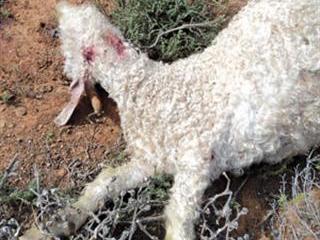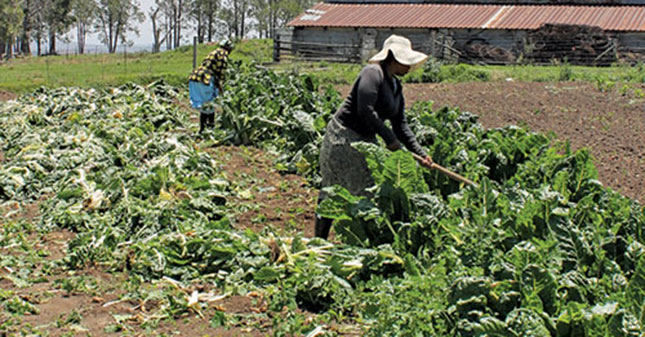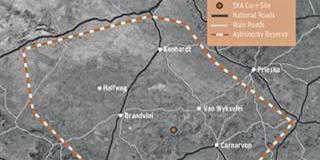
What is the forum’s strategy?
We have introduced a practical predator control system covering an area of about 100km x 100km which will work well once all landowners participate. It involves contracting experienced night shooters, houndsmen and trappers at critical times of the year and rewarding them well for successful hunts.
We have divided the district into units of six landowners each, with a leader to co-ordinate operations. We will also identify predator hot spots and focus on them, while maintaining general vigilance. Each landowner can negotiate his own rates. For example, R750 per jackal or caracal, plus R500 as a night hunting fee. However, farmers are encouraged not to rely on night shooters exclusively but to use all legal methods available, whatever suits them best.
There is no intention of exterminating the predators. That would be impossible given the rate at which they breed and the huge supply of prey at their disposal. A breeding pair of black-backed jackals, for example, can multiply to 26 in 13 months. At the moment we estimate that there are six jackal (three breeding pairs) in every thousand hectares. We could live with two jackal (one breeding pair) per 1 000ha.
This sounds like an expensive operation?
It is expensive, but the losses are even more so. Now that local government no longer assists farmers with predator control it’s up to the farmers’ organisations to self-administer and finance bounty systems. Obviously this means zero tolerance of interference from state departments or NGOs. The predation ‘theft’ is too serious for us to allow others to dictate conditions concerning our future.
People must understand that margins have diminished in recent decades and that there has been a huge reduction in farmer numbers worldwide. Losses – including predation losses – must be cut to the minimum to keep those remaining in the business viable. Successful predator control will stem job losses in farming areas and ensure livestock farming remains a viable producer of food and foreign exchange.
Why do you regard active predator control by all landowners as so important?
Small-stock farming, mutton, wool, mohair and goat meat, the region’s main economy is under serious threat due to an increase in predators, particularly black-backed jackal and caracal. If they increase at current rates, without any measures to counter their population growth, small-stock farming will cease to be economically viable by 2020.
Every landowner – including the state – has a duty to effectively control these predators and to participate in a strict predator management programme. In fact, our predator management forum plans to identify those landowners who are apathetic about how predation affects their neighbours. We will visit them and try to explain to them why it is important for them to commit to the common cause.
Bona fide livestock farmers cannot allow game farms or weekend retreats to breed predators that disperse into the district and make it impossible for them to profitably rear lambs and kids. Apathetic or misguided landowners, often newcomers to the area who do not understand animal dynamics on stock farms, are simply not being fair to the community at large when they refuse to control predators on their properties.
In general, we would like the owners of wildlife properties who have little farming knowledge to become more active and take more interest in their communities. If they do not they will eventually be completely sidelined because farmers who combine livestock and game farming (like myself) will soon prefer to side with provincial agricultural unions instead of wildlife organisations.
Are the proposed measures not too drastic? What about non-lethal methods of control?
I call them hypothetical control measures and am convinced the introduction of electric fencing, protective collars and livestock guarding dogs has worsened rather than eased the predation problem. The reason is that by trying out these methods, farmers stopped hunting the predators, which then obviously had a great opportunity to multiply, and prey on a large variety of other food sources.
Some of the non-lethal methods do work, but usually only until the jackals have habituated to them. Eventually not even electric fencing keeps them out. So, even when non-lethal methods are used, predators still have to be hunted to keep their numbers manageable. If they are not hunted, they will come back and overrun farmers. Predators must (and do) kill to eat.
Jackal, caracal and leopard are beautiful animals and no one enjoys killing them, but the only way to ensure survival for small-stock farmers is to keep their populations under control. Remember, they no longer have natural enemies to do that.
Farmers say the Department of Environmental Affairs is not giving the necessary support.
There are double standards here. It is well known that huge numbers of jackals are being shot in national parks because park managers have realised that not hunting them results in the decimation of game such as springbok and many other smaller buck. This soon leads to the expensive buying-in of these species. But when farmers hunt predators for the same reasons they get no support and are heavily criticised for it.
We would also like the department to consult with us before taking decisions that affect us. For example, the Cape fox has recently been put on the Threatened or Protected Species list, despite the fact that these predators prey on newborn farm and game animals and that there is no evidence that the Cape fox is under threat. They might even be on the increase.
State departments should attend farmers’ meetings and listen to our views, which are usually based on practical experience rather than academic theories.
Most of the research results come from game parks where the predator component and the prey base differ from those on stock farms. It is disappointing that the national and provincial predator management forums, which have regularly met for the past five years, have made no progress. In contrast, our strategy is already bearing fruit – after only a few months in operation. The current lambing season is still in progress and members are already reporting much bigger crops.
How do these predators affect game farms?
It is a mistake to think that predators cause damage only on stock farms. Game farmers who do not exercise effective predator control find their populations of smaller mammals diminishing. Night hunters say small game species are more abundant on sheep farms where predators are controlled than on game farms where they are not. Urban businessmen
who develop game farms are often misled by ecologists and animal welfare people about predator-prey and predator-predator relationships. Running an eco-tourism ranch is fine but it should not be done at the expense of the neighbouring farming community.
Contact Arthur Rudman on 083 280 1335.
The views expressed and procedures proposed here do not necessarily reflect those of Farmer’s Weekly. We know this topic is highly controversial and will, in the interest of fairness and balance, publish a follow-up article highlighting the opposing view in a future issue. Readers are in the meantime welcome to comment.













